The blue dolphin cichlid (Cyrtocara moorii) is a striking aquarium fish native to Lake Malawi in Africa. Known for its vibrant blue coloration and distinctive body shape, this cichlid has captivated the interest of aquarium enthusiasts.
The blue dolphin cichlid is particularly popular among cichlid fans due to its eye-catching blue hue and its unique body structure, which features a prominent bump on its head resembling a dolphin’s snout. This unusual shape, combined with its bright color, makes it a standout species in the aquarium world.
Its appearance not only adds a splash of color to any tank but also showcases the diverse and fascinating adaptations of cichlids from Lake Malawi.
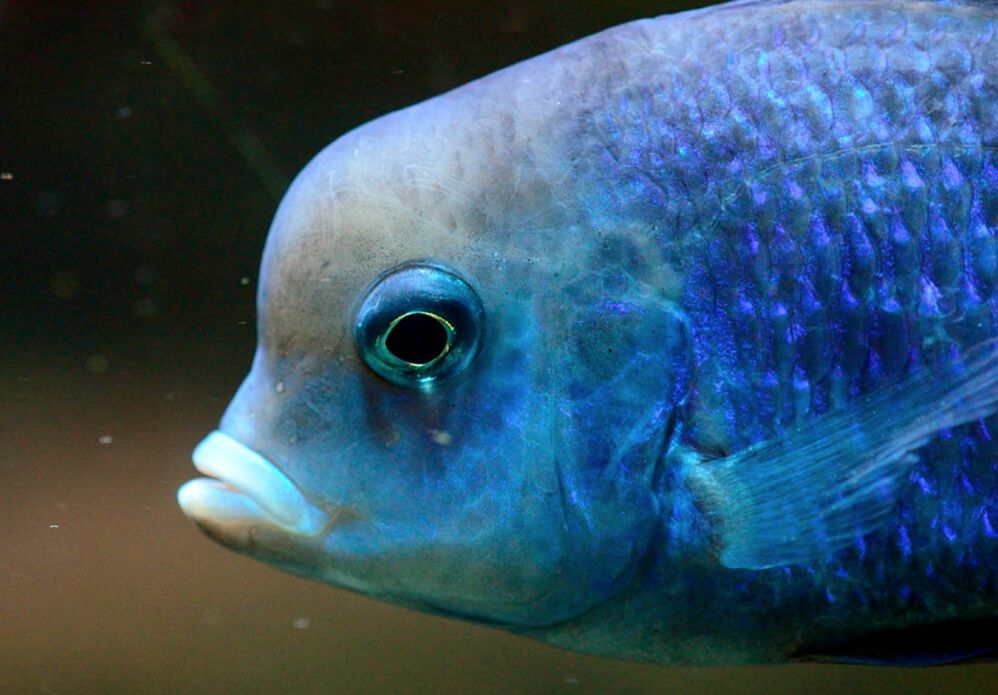
Contents
Habitat in the wild
The blue dolphin cichlid (Cyrtocara moorii), first described by Boulanger in 1902, is a captivating species native to Lake Malawi in East Africa. This lake, renowned for its rich biodiversity, serves as the primary habitat for this striking fish. The blue dolphin cichlid is widely distributed throughout the lake, favoring rocky shores and sandy areas along the coast.
In the wild, blue dolphin cichlids thrive in the rocky and sandy zones of Lake Malawi, typically found in depths ranging from 3 to 15 meters. They are often seen congregating around large boulders and rocky outcrops, where they sift through the sediment in search of food and create pits for spawning. These fish are part of a dynamic rocky shoreline community that includes various cichlid species, all of which rely on the complex rock formations, crevices, and caves for hiding and territorial purposes.
Blue dolphin cichlids are known for their stable, multi-aged communities. In their natural habitat, a single dominant male usually leads a harem of 3-4 females, with the territory being fiercely guarded during the spawning period. Despite their territorial nature, blue dolphin cichlids exhibit a generally peaceful demeanor outside of breeding times and have been observed joining other species with similar habits for feeding. This social structure and behavior contribute to the species’ unique presence in the diverse ecosystem of Lake Malawi.
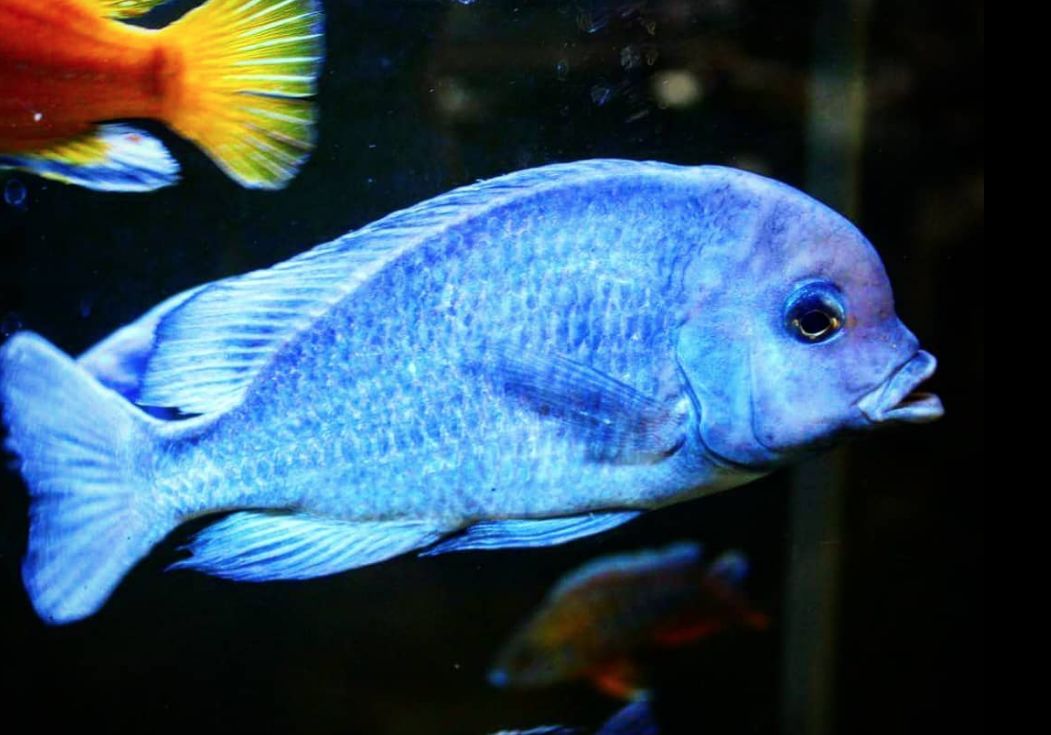
Description
Size
The blue dolphin cichlid (Cyrtocara moorii) is a moderately sized fish, with males typically outgrowing females. Here’s a breakdown of the average sizes for this species:
- Males: can grow to about 8 to 10 inches (20 to 25 centimeters) in length. Exceptional individuals may reach slightly larger sizes, showcasing their robust and prominent features.
- Females: are generally smaller than males, averaging around 6 to 8 inches (15 to 20 centimeters) in length. While still sizable, they tend to have a more streamlined appearance compared to their larger male counterparts.
Growth rate
Blue dolphin cichlids experience relatively rapid growth during their juvenile stage. In the first few months of their life, they can grow quite quickly, often reaching several inches in length within the first year. As cichlids enter their subadult stage, their growth rate typically slows down compared to their juvenile phase. They continue to grow but at a more moderate pace. Blue dolphin cichlids reach their adult size at around 2 to 3 years of age.
Lifespan
They have an average lifespan of approximately 8 to 10 years in captivity. However, with proper care and a suitable environment, they can sometimes live up to 12 years or even longer.
Body and color
The blue dolphin cichlid is a striking fish with a distinctive appearance that resembles its namesake. Characterized by its elongated and stocky body, it features a prominent hump on its head, giving it a dolphin-like look.
Physical Characteristics:
- Body Shape: The cichlid has a laterally compressed body with a broad forehead and a slightly pointed snout. This unique body shape contributes to its dolphin-like appearance.
- Coloration: Adults are predominantly blue, but the exact shade can vary. Juveniles and females may display more subdued hues such as brown or gray. As they mature, both males and females develop a noticeable lump on their forehead, known as the nuchal bump or hump.
- Fins and Spots: The body color is primarily blue, often adorned with varying numbers of black spots on the fins. These spots can change depending on the fish’s habitat and environmental conditions.
During skirmishes or displays of aggression, the blue dolphin cichlid’s fins and neck may darken to nearly black, while its body color brightens to a vivid blue. This dramatic color change enhances their visual impact and is part of their unique behavior in the wild.
| Characteristic | Description |
|---|---|
| Scientific Name | Cyrtocara moorii |
| Common Name | Blue dolphin cichlid |
| Native to | Lake Malawi, East Africa |
| Size | Males: 8-10 inches (20-25 cm); Females: Slightly smaller than males |
| Body Shape | Laterally compressed with a broad forehead and pointed snout |
| Coloration | Adults: Predominantly blue; Juveniles and females: Muted colors (brown or gray) |
| Behavior | Generally peaceful and social, but can be aggressive |
| Diet | Omnivorous |
| Natural Habitat | Rocky shores and sandy areas of Lake Malawi |
| Water Parameters | Temperature: 75-82°F (24-28°C), pH: 7.5-8.5 |
| Breeding | Mouthbrooders: Females carry and protect fertilized eggs in mouth |
| Aquarium Care | Spacious tank with rocks and caves for hiding and territories |
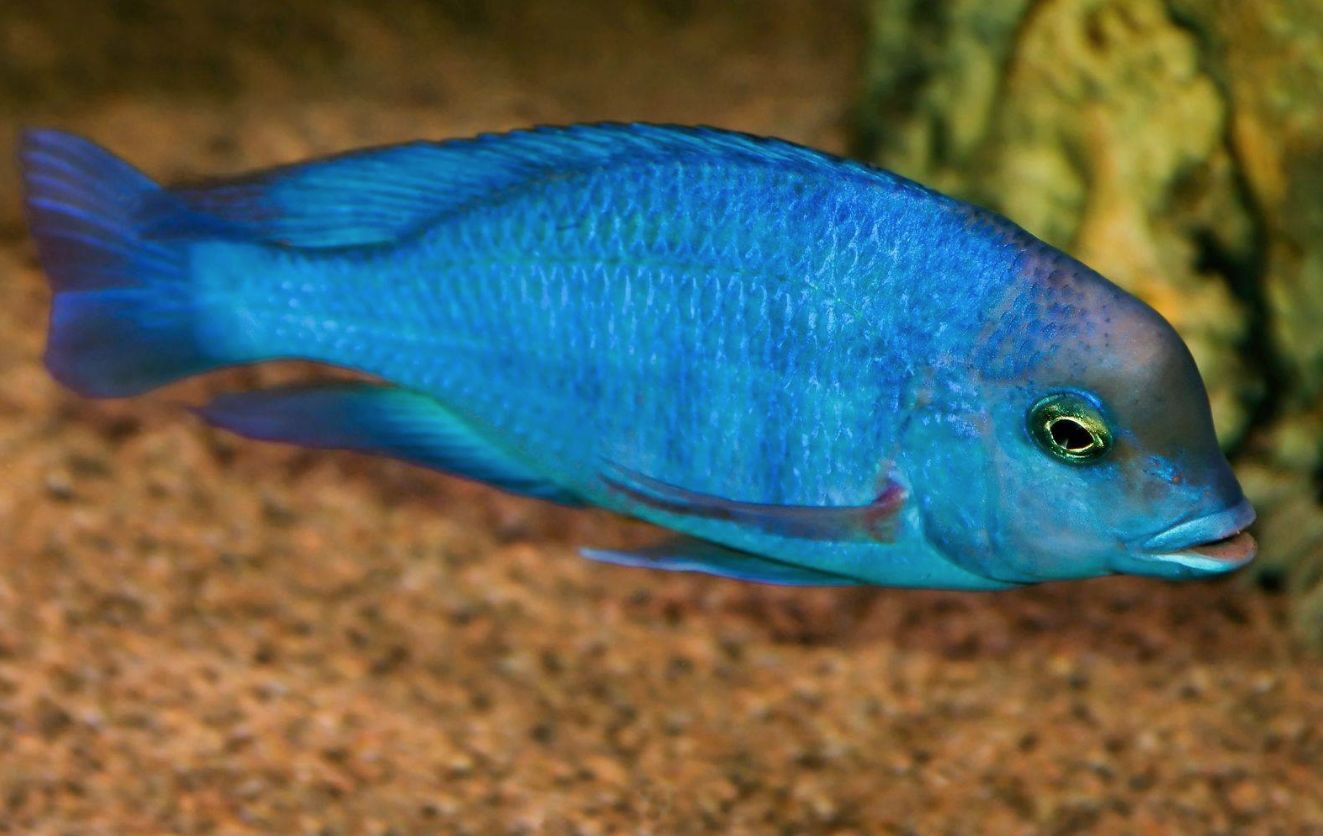
Difficulties in keeping
Keeping in a tank is rather easy under the condition that they live in a spacious aquarium with clean water that has stable parameters and the aquarium is designed appropriately. It’s better to design it as a biotop with a sandy bottom that has a big number of rocks and different covers which leave enough space for the fish to swim.
Is a fish to be recommended both to experienced and advanced aquarists. The blue dolphin cichlid isn’t the one for amateurs since it requires a spacious tank, frequent water renew and correctly chosen tank mates.
Although the fish is rather peaceful they aren’t good for a community tank. The best tank mates are some other Malawi fish types or african catfishes.
Care and keeping in a tank
Tank size
Blue dolphin cichlids are active and relatively large fish, making it crucial to provide them with an adequately sized tank to ensure their well-being and comfort. Their tank size requirements vary depending on whether you plan to keep them as a single specimen or as part of a community setup.
Tank Size and Capacity:
- Single Specimen: For a single blue dolphin cichlid, a tank with a minimum capacity of 55 gallons (208 liters) is recommended. This size offers sufficient swimming space and allows the fish to establish its territory comfortably.
- Community Setup: If you plan to house cichlids with other compatible fish species from Lake Malawi, such as mbuna cichlids, a larger tank is essential. A tank size of at least 75 gallons (283 liters) is ideal to accommodate the aggression and territorial nature of these cichlids.
Impact of Tank Size:
- Growth and Development: Blue dolphin cichlids can reach a maximum size of about 6-8 inches (15-20 cm) in larger tanks. In smaller tanks, they may remain smaller due to limited space. Additionally, the distinctive nuchal bump (forehead hump) that males develop is more prominent in adequately sized tanks. Smaller tanks may inhibit the full development of this feature.
- Swimming Space and Cover: While it’s essential to provide ample hiding spots and covers, such as rocks and caves, ensure that there is also sufficient open swimming space. Cichlids primarily inhabit the middle and lower water layers, so the tank should cater to their spatial needs.
By providing a spacious and well-designed tank, you will not only enhance the health and growth of your blue dolphin cichlid but also support its natural behaviors and physical development.
Tank decor
As for the tank design – the bottom is better to be sandy where fish likes to dig. They don’t need any plants since they either dig them out or eat them.
It’s better to add lots of big rocks, snags and other types of covers in a tank. Also it’s recommended to keep blue dolphin cichlid in a species tank, since the fish is rather timid. In general, the fish is peaceful enough, though the males can sometimes have fights as for their dominance.
It’s desirable to have more females than males in a tank: for example, one male and two females or two females and three males.
Cichlid has a specific manner of behavior: it’s not fussy and its movements are slow. In Malawi Lake water parameters change insignificantly, plus the water is very hard and it has alkali reaction.
Water parameters
To ensure the health and well-being of your blue dolphin cichlid, it’s crucial to maintain the following optimal tank parameters:
- pH: 7.0 – 8.0
- Hardness (dGH): 10 – 25 dGH
- Temperature: 21–27°C (70–81°F)
Diet
As for the feeding type blue dolphin cichlid is closer to benthos feeders, but it doesn’t have a strict specialization in feed. In their natural habitat of Lake Malawi, they are opportunistic omnivores. Along with worms of benthic spineless the blue dolphin also feeds on organic debris, different kinds of drifting life and soft supreme phreatophyte.
Blue dolphin cichlids feed on algae, plant material, and detritus. They use their specialized pharyngeal teeth to scrape and graze on the surfaces of rocks and substrates in search of algae and biofilm. In an aquarium setting, it’s essential to provide them with a suitable vegetable-based diet. This can be accomplished by offering high-quality spirulina-based flakes or pellets, blanched vegetables like spinach or zucchini, and algae wafers.
In the tank eats all types of feed – artificial, live, frozen, plant one. But the feed should have high contain of proteins, for example, blood worms or brine shrimp, earthworms. In the wild, they feed on small invertebrates and insect larvae. In captivity, you can supplement their diet with high-quality cichlid pellets or flakes that contain a good balance of protein.
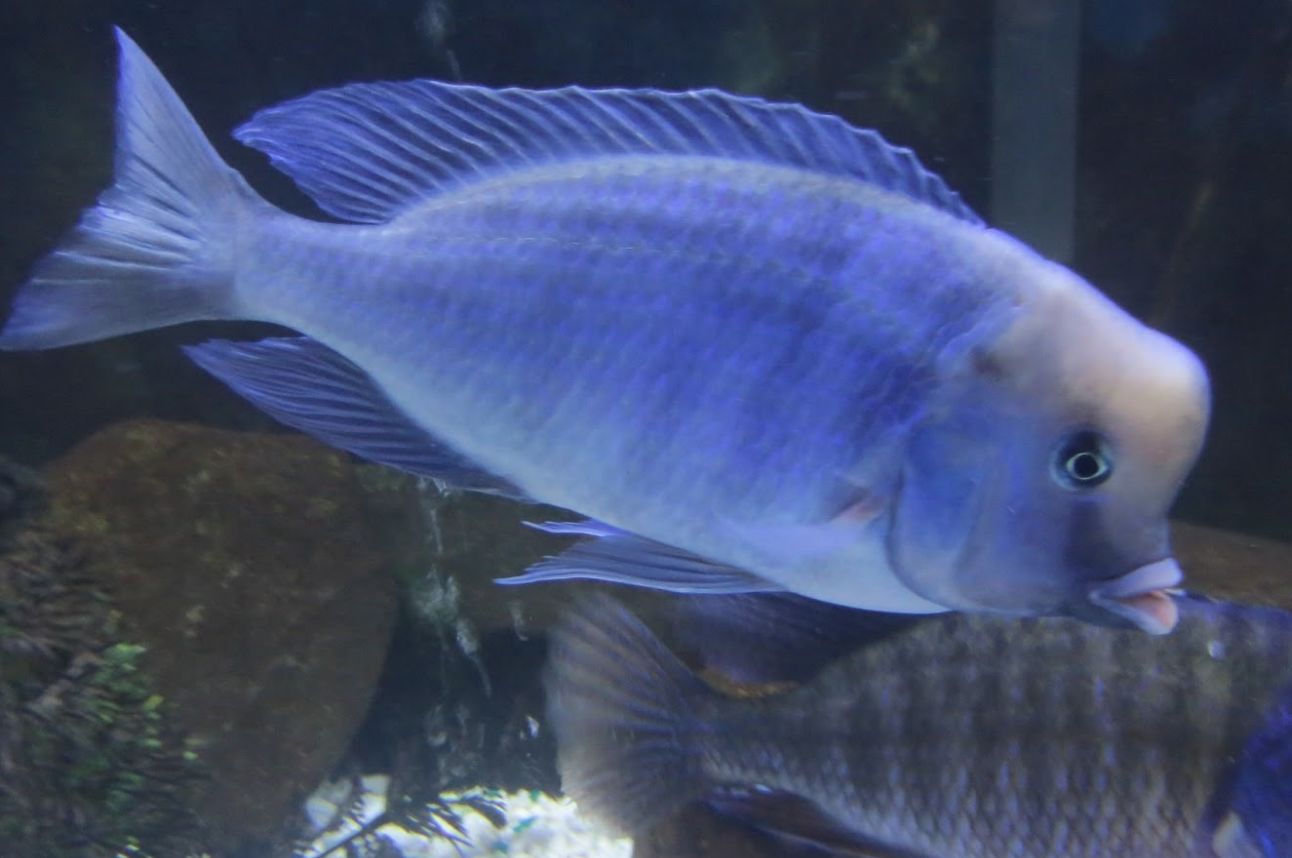
Tank mates
It’s a rather quiet cichlid, but the fish is sure not for the community tank. Cyrtocara moorii can display aggression, particularly during breeding and territorial disputes. However, compared to some other cichlid species, they are generally considered to be relatively peaceful. Their aggression is typically less pronounced when compared to more aggressive mbuna cichlids found in Lake Malawi.
It’s important to note that individual fish may exhibit varying levels of aggression, and their behavior can also be influenced by factors such as tank size, water parameters, and the presence of other fish in the aquarium. Providing enough space, hiding spots, and territories within the tank can help minimize aggression among blue dolphin cichlids and promote a more harmonious environment.
Blue dolphin cichlid can inhabit together with other Malawi fishes, but it’s desirable to avoid mbuna, because its very aggressive and disquiet. In some cases, peaceful cichlid species from Lake Tanganyika can also be compatible with this cichlids. Look for species such as Julidochromis, Neolamprologus, or some Altolamprologus species.
They are good tank mates for with the fish of equal size, but smaller fish is treated only as feed. It’s good to have frontosa cichlid and big african like sailfin pleco as tank mates. Some non-cichlid fish can also be compatible tank mates for blue dolphin cichlids. Peaceful bottom-dwelling species like certain species of catfish (e.g., Corydoras or Synodontis) can work well.
Gender differences: male vs female
In blue dolphin cichlids, distinguishing between males and females involves several key differences in appearance and behavior:
- Size:
- Males: Typically larger, reaching an average length of 8 to 10 inches (20 to 25 centimeters).
- Females: Slightly smaller, averaging around 6 to 8 inches (15 to 20 centimeters).
- Coloration:
- Males: Exhibit more vibrant and intense colors, displaying a striking blue hue across their bodies.
- Females and Juveniles: Generally have more subdued colors, often appearing brown or gray.
- Forehead and Body Shape:
- Males: Develop a more pronounced hump on the forehead, known as the nuchal bump. They may also have a slightly more elongated body compared to females.
- Females: Have a less pronounced forehead bump and a more rounded body shape.
- Behavior:
- Males: Tend to be more aggressive and territorial, particularly during breeding or when establishing dominance.
- Females: Generally more peaceful and less aggressive, focusing on preparing the breeding site and caring for the young.
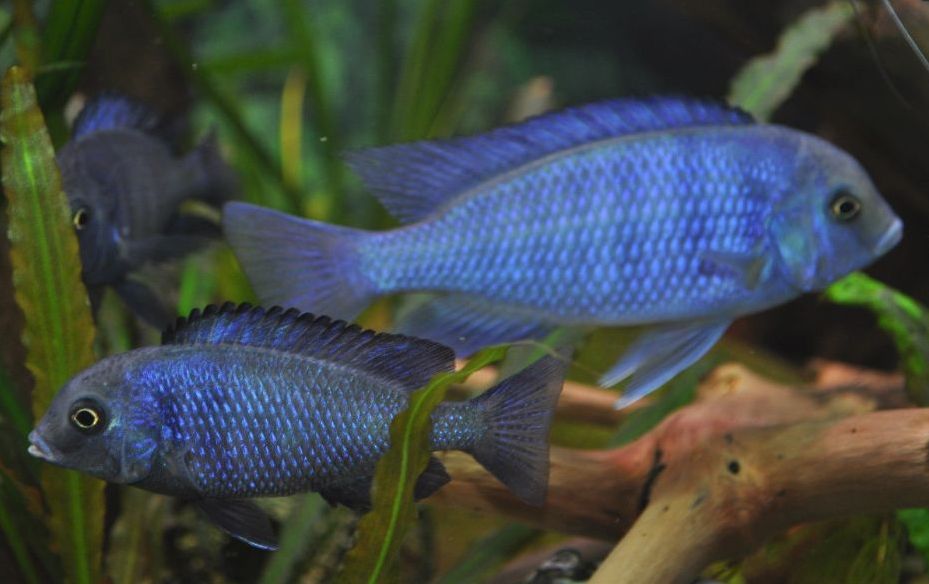
Breeding
They are polygamous, they create a family consisting of a male and several females. There can be 3-6 females for one male. Since the gender of a fish is difficult to be defined, the best way is to create a harem of 10 juveniles and grow them together.
The blue dolphin cichlid juveniles become reproductive when reaching the body length 12-15 cm and then they should be separated. Water parameters for breeding are the following: hardness 5 -20°, pH 7.5-9.0, temperature 25 – 28 °C. The couple takes part in spawning.
Male becomes rather aggressive when protecting its territory, as for the female it becomes timid (when it gets scared it can swallow the eggs) therefore it should be protected from stress.
The blue dolphin cichlid female breeds on a flat rock or into the hole dug by the male in advance, or just on the bottom. The female breeds 1-3 eggs in a time, then she takes them into her mouth and gets to the male anal fin to fertilize them.
The fruitfulness of the couple is from 20 to 90 eggs. The female carries eggs in its mouth for 21 days. During this period the female doesn’t eat a thing and it can get weak, therefore some aquarists try to grow the eggs in an incubator. To do so they take a spawned-out female and release the eggs from her mouth.
They put the eggs into the tank with clean water, soft lights and water passage. The water should have the same parameters that the one in the big tank.
On the 7th day the blue juveniles start going outside and feed, but hey hide back into the female mouth with the slightest sign of danger or for the night time. Start feed is brine shrimp eggs.
The juveniles from the beginning are silver colored with black stripes and than when reaching 4-5 cm in size they become blue and grow very slowly.